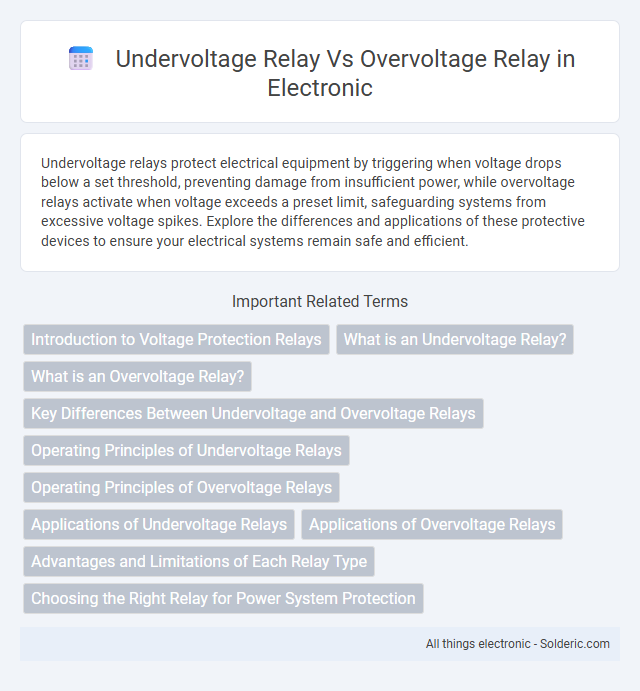Undervoltage relays protect electrical equipment by triggering when voltage drops below a set threshold, preventing damage from insufficient power, while overvoltage relays activate when voltage exceeds a preset limit, safeguarding systems from excessive voltage spikes. Explore the differences and applications of these protective devices to ensure your electrical systems remain safe and efficient.
Comparison Table
| Feature | Undervoltage Relay | Overvoltage Relay |
|---|---|---|
| Function | Detects voltage drops below a preset threshold | Detects voltage rises above a preset threshold |
| Purpose | Protect equipment from low voltage damage | Protect equipment from high voltage damage |
| Operation | Trips circuit when voltage falls below set value | Trips circuit when voltage exceeds set value |
| Application | Motors, transformers, and power systems during undervoltage conditions | Generators, transformers, and installations prone to overvoltage |
| Typical Voltage Range | Below rated voltage (e.g., < 90% of nominal) | Above rated voltage (e.g., > 110% of nominal) |
| Response Time | Fast to prevent damage from voltage sags | Fast to prevent insulation breakdown or equipment failure |
| Common Uses | Unstable power supplies, brownouts protection | Lightning protection, sudden voltage surges |
Introduction to Voltage Protection Relays
Voltage protection relays safeguard electrical systems by detecting abnormal voltage conditions and triggering protective actions, with undervoltage relays responding to voltage drops below a set threshold and overvoltage relays activating when voltage exceeds safe limits. These relays play a critical role in preventing equipment damage, ensuring system stability, and maintaining power quality in industrial and utility networks. Understanding the differences between undervoltage and overvoltage relays helps you select the appropriate protection to enhance the reliability and safety of your electrical installation.
What is an Undervoltage Relay?
An undervoltage relay is a protective device designed to monitor the voltage level in electrical circuits and activate when the voltage falls below a predetermined threshold, preventing damage to equipment caused by low voltage conditions. Unlike overvoltage relays, which respond to excessively high voltage, undervoltage relays ensure system stability by disconnecting loads or triggering alarms during voltage sags. These relays are crucial in safeguarding motors, transformers, and other electrical components from malfunction or failure due to insufficient voltage supply.
What is an Overvoltage Relay?
An overvoltage relay is a protective device that detects when the voltage in an electrical system exceeds a predetermined threshold, preventing potential damage to equipment. Your electrical installations remain safe by promptly disconnecting circuits during abnormal voltage surges, thereby enhancing system reliability. Overvoltage relays are critical components in power distribution networks, safeguarding transformers, motors, and other sensitive devices from voltage spikes.
Key Differences Between Undervoltage and Overvoltage Relays
Undervoltage relays activate when the voltage falls below a predetermined threshold, protecting electrical equipment from damage due to insufficient voltage levels. Overvoltage relays, in contrast, trip circuits when voltage exceeds a set limit, preventing equipment malfunction caused by excessive voltage. Key differences include their operational voltage conditions, protection focus--undervoltage for low voltage scenarios and overvoltage for high voltage scenarios--and their specific applications in safeguarding electrical systems.
Operating Principles of Undervoltage Relays
Undervoltage relays operate by monitoring voltage levels and triggering a trip when the voltage falls below a set threshold, protecting electrical equipment from damage caused by insufficient voltage. These devices use electromagnetic coils or electronic sensors to detect voltage dips, ensuring the stability and safety of power systems. Your electrical system benefits from reliable operation as undervoltage relays prevent malfunctions and maintain proper voltage supply.
Operating Principles of Overvoltage Relays
Overvoltage relays operate by continuously monitoring the voltage level and activating when it exceeds a predetermined threshold to protect electrical equipment from damage caused by high voltage conditions. These relays utilize voltage sensing circuits, often based on electromagnetic or solid-state components, to detect abnormal voltage spikes rapidly. Your electrical system's reliability depends on the precise functioning of overvoltage relays to prevent insulation failure, equipment overheating, and potential power outages.
Applications of Undervoltage Relays
Undervoltage relays are primarily applied in electrical systems to protect equipment from voltage drops that could lead to malfunction or damage, such as in motor control circuits, transformers, and power distribution networks. These relays ensure system stability by disconnecting loads during low voltage conditions, preventing motors from stalling and safeguarding sensitive devices. Common applications include industrial automation, uninterruptible power supplies (UPS), and control panels in manufacturing plants.
Applications of Overvoltage Relays
Overvoltage relays protect electrical equipment from damage caused by voltage levels exceeding preset thresholds, making them essential in power systems, transformers, and capacitor banks. Your electrical network benefits from these relays by preventing insulation breakdown, equipment failure, and operational downtime during voltage surges. They are widely applied in substations, industrial plants, and renewable energy installations to ensure system stability and reliability.
Advantages and Limitations of Each Relay Type
Undervoltage relays offer precise protection against voltage drops, preventing equipment damage and system instability by disconnecting circuits during low voltage conditions, but they may lead to unnecessary outages in cases of temporary voltage dips. Overvoltage relays safeguard electrical systems from excessive voltage levels, reducing risks of insulation failure and equipment burnout, yet they can be less effective in detecting slow voltage rises or transient surges. Both relay types enhance system reliability, but their effectiveness depends on specific application requirements and the nature of voltage disturbances.
Choosing the Right Relay for Power System Protection
Undervoltage relays protect power systems by detecting voltage drops below a preset threshold, preventing equipment damage and system instability. Overvoltage relays monitor excessive voltage levels that can cause insulation failure and equipment overheating, ensuring system reliability. Selecting the right relay involves assessing voltage stability requirements, load sensitivity, and coordination with other protective devices to maintain optimal power system performance.
Undervoltage relay vs overvoltage relay Infographic

 solderic.com
solderic.com